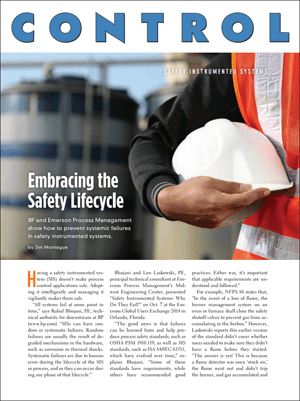Process safety revolves around managing the risks of your production process throughout the life of your plant, mill or production facility. The international safety standard, IEC 61511 (Functional safety – Safety instrumented systems for the process industry sector):
…sets out practices in the engineering of systems that ensure the safety of an industrial process through the use of instrumentation. Such systems are referred to as Safety Instrumented Systems.
 A Control magazine article, Embracing the Safety Lifecycle, shares the story of how BP and Emerson Process Management worked together to help in the process of mitigating risks inherent in oil refining through the application of the IEC 61511 standard.
A Control magazine article, Embracing the Safety Lifecycle, shares the story of how BP and Emerson Process Management worked together to help in the process of mitigating risks inherent in oil refining through the application of the IEC 61511 standard.
BP’s Rahul Bhojani noted that all systems fail at some point and noted:
SISs can have random or systematic failures. Random failures are usually the result of degraded mechanisms in the hardware, such as corrosion or thermal shocks. Systematic failures are due to human error during the lifecycle of the SIS or process, and so they can occur during any phase of that lifecycle.
Knowing that failures can occur helped to produce and refine the process safety standards such as OSHA PSM 1910.119 and ISA84/IEC 61511.

Len Laskowski
Principal Technical Consultant
…didn’t cover whether users needed to make sure they didn’t have a flame before they started.
He explained:
“The answer is yes! This is because a flame detector was once ‘stuck on,’ the flame went out and didn’t trip the burner, and gas accumulated and caused an explosion…”
The standard was improved to require the verification that:
…no flame is present as part of the safe-start check.
Rahul advised important steps in managing the safety system lifecycle:
- Attend a thorough hazard and operability (HAZOP) study.
- Verify the layers of protection analysis (LOPA) evaluation.
- Have a complete safety requirements specifications (SRS) analysis.
- Install new functioning hardware.
- Install new tested software.
- Conduct regular proof tests.
- Train world-class operators.
- Use engineered trip setpoints or process delay time.
Len emphasizes the importance of identifying all potential initiating causes, such as:
…when all fuel sources to BMSs [burner management systems], SRUs [sulfur recovery units] and thermal oxidizers aren’t identified… Likewise, during overfills, all inlet lines, not just big ones, need to be identified as closing on high level. Also, loss of utilities like power, steam, cooling water and instrument air can lead to initiation, and need to be identified.
Read the article for more as they share important points on adopting a three-part safety lifecycle procedure, developing an interaction matrix, identifying common causes which may negate independent protection layers (IPLs), focusing lifecycle management on fewer managed IPLs than more unmanaged ones.
You can also connect and interact with other process safety experts in the Safety Instrumented Systems group in the Emerson Exchange 365 community.




